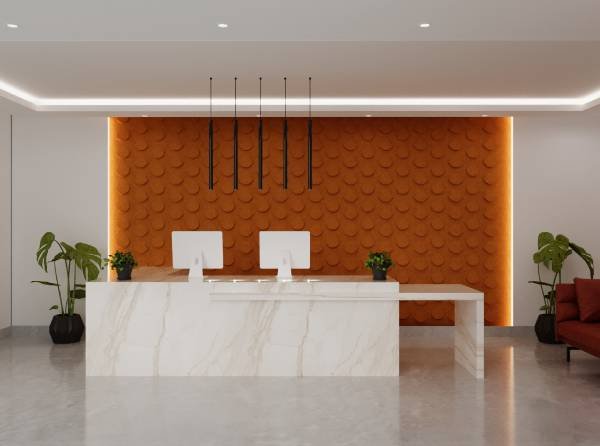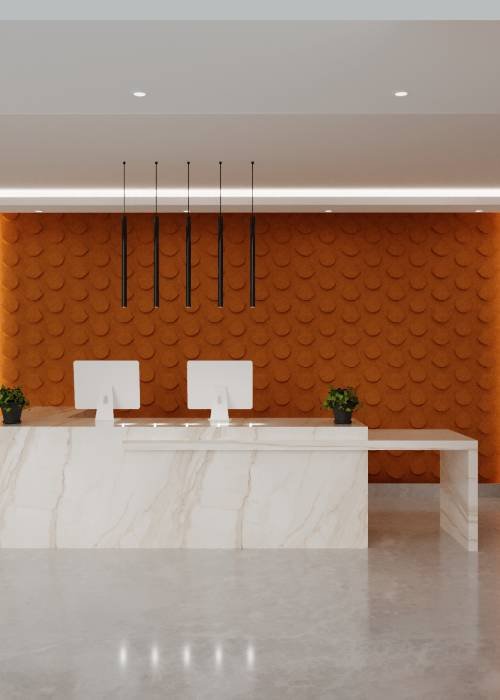Acoustic boards help lessen undesirable reflected sound in any room...
Wide, soft-furnished panels that can be strategically positioned inside rooms to increase sound quality are known as acoustic wall panels. Acoustic panels are commonly made of a mixture of foam and fabric and can be cut into various shapes and sizes to match the design of your room.


Bad ceiling acoustic panels can affect health, communication, safety, productivity, and learning, so acoustic comfort in an office room, school, or public building contributes to our well-being.
Good quality acoustic ceiling boards are becoming increasingly common in a variety of settings.
Acoustic tile ceilings can be used in businesses, industrial buildings, and classrooms. Acoustic walls and ceilings not only look fantastic, but they also reduce noise.
Depending on the intended function and effect, acoustic panels may be built as absorbers or diffusers.
The key construction methods for changing the acoustic conditions of rooms, semi-enclosed spaces, and the outdoor environment are absorbers and diffusers. It is important to use them correctly to achieve high-quality acoustics.
Our experts will outline the best approach for you during our in-depth consultation process.
Acoustic board price lists are the perfect solution if you’re short on wall space, as we stated briefly in the introduction, and get to work out on budget.
Many of the offices and restaurants we visit have a clear brand image, often expressed in the wall décor. The last thing they want is for unappealing panels to be hung on the walls..
Acoustic board ceiling materials are great because they don’t need you to cover an entire wall to acoustically solve a noise problem. Our experts will determine the first point of contemplation, which will help them determine where the wall panel should be placed.
Ceiling height is critical since poor acoustics will result from sound needing to travel higher in the air due to the ceiling height. Sound is stuck in the dead space above your ears, creating reverberation periods and lengthening the time it takes for the sound to become unheard. Often, acoustics that echoes off hard surfaces have a longer reverberation duration, which means they can be heard for a longer time, so acoustic for the ceiling is an important consideration.
Acoustic panel manufacturers have typically suspended ceiling structures with carriers suspended from the room’s actual ceiling and individual panels of sound-absorbing material lowered into pieces. This form of ceiling also has the potential to conceal heating and cooling ducts, as well as unsightly wires and pipes.
Ceiling tiles come with a variety of textures and patterns. When most people think of acoustic ceiling tiles, they think of the less expensive mineral fiber tiles that have traditionally been used to help with noise reduction. Modern acoustic ceilings, on the other hand, maybe real architectural highlights. Metal, wood, and even textiles like felt can be used to make stunning acoustic creations.
Most of us are aware of the importance of speaker efficiency and quantity. For instance, how does a movie sound on your laptop versus in a theatre? Room acoustics, on the other hand, is concerned with how sound interacts with a physical room. Space acoustics play a big role in why a movie sounds better in the theatre, and an orchestra sounds better in a concert hall.
The room’s shape, the use of absorptive and reflective paneling, furniture selection and positioning, ceiling height, and construction materials all contribute to the acoustic profile of a given space.
A conferencing room with a low acoustic profile decreases the amount of time it takes for listener exhaustion to set in and attendees to leave. In cases where audio and video conferencing systems are used, these issues may be compounded.
If the space has parallel walls, a lot of glass or other reflective surfaces, and little or no soft surfaces, the acoustics are likely to concern. Listen to different parts of your space to see how well it works. Request a few minutes of a colleague’s time and attempt to converse at a regular volume at opposite ends of the room or conference table.
Once you’ve determined that your room has acoustic problems, it’s time to address them. The best false ceiling acoustic panels for a home will depend on the type of room you’re working on, but there are a few simple fixes you can try: Getting a lot of acoustic absorption is one of the most important aspects of an acoustic room design. But what exactly is absorption, and how does it work in a room?
Depending on the structure and materials that sound waves strike in a space, they are reflected or absorbed. Clear, smooth surfaces, such as glass tables or large windows, bounce (reflect) the waves. Soft, porous surfaces like fabric curtains or panels, on the other hand, absorb them.
Improving the acoustics of your meeting and conference rooms at your company or organization can also contribute to increased efficiency and revenue. Meeting rooms are often designed with little thought, but a few basic enhancements will help the employees hear each other better in meetings, resulting in better ideas, engagement, and collaboration. Experts from Unidus will be able to hear and understand your pitches better, and you will hear their input as well. A few simple acoustic improvements for your rooms will improve interaction and performance.
Acoustic boards help lessen undesirable reflected sound in any room...
Acoustic boards help lessen undesirable reflected sound in any room...
Open spaces have been known as the trending layout for...
WhatsApp us